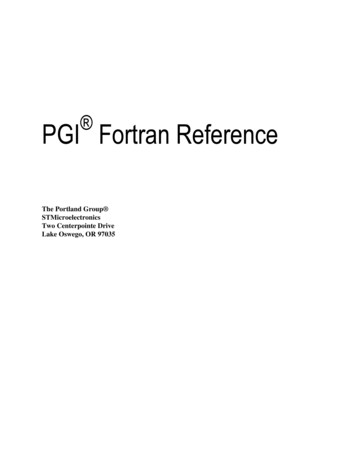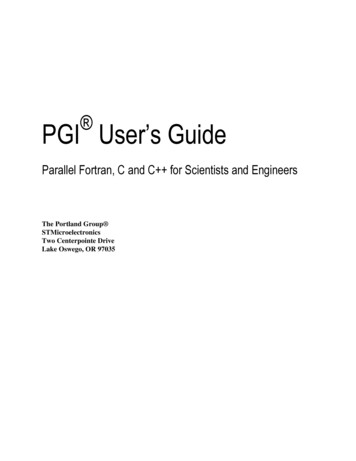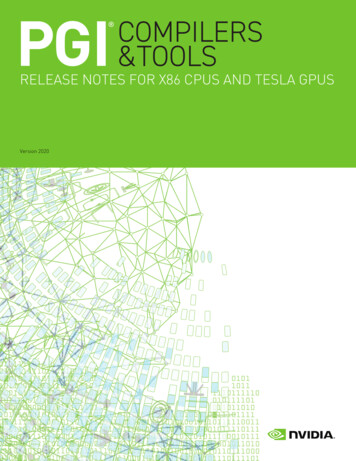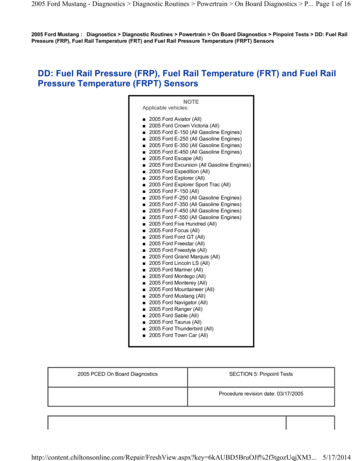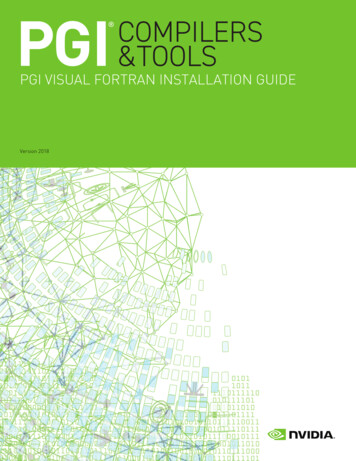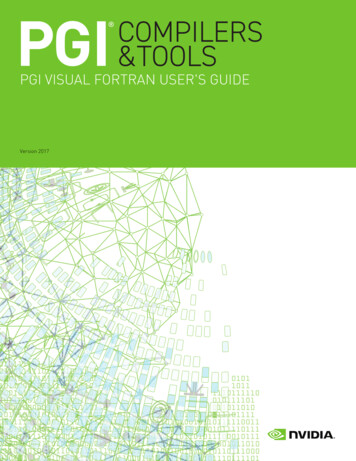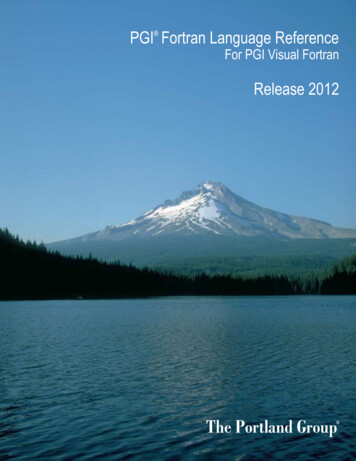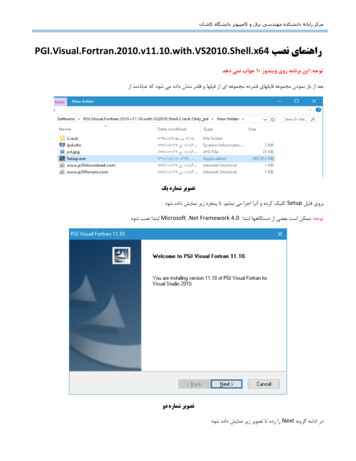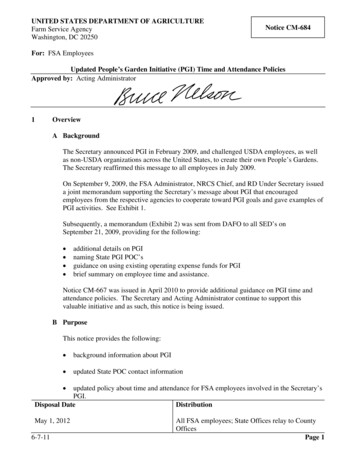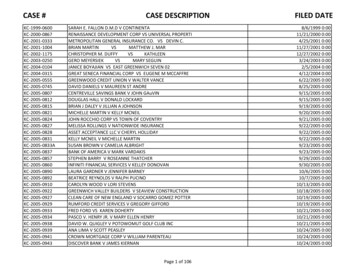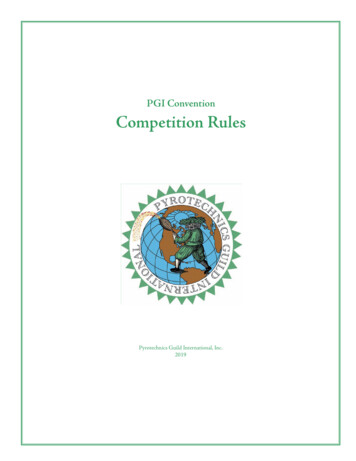
Transcription
PGI ConventionCompetition RulesPyrotechnics Guild International, Inc.2019
1PGI CONVENTION COMPETITION RULES2019Table of Contents1.Competition Overview.33.Special Awards.4Grand Master.4Life Master.4Bill & Sue Hoyt Prize.4Gerry Gits Challenge.4Best First Time “B” Competitor.4Best First Time “C” Competitor.4The Club Trophy.42.General Rules.5Competitor Eligibility.5Device Requirements.5Competition Conduct.5Safety.54.Competition Specifications.6Division 1: Aerial Shell Competition.6Competition 1-1: Aerial Level 1 (Beginner).7Competition 1-2: Aerial Level 2 (Novice).7Competition 1-3: Aerial Level 3 (Intermediate).7Competition 1-4: Aerial Level 4 (Advanced).7Competition 1-5: Aerial Level 5 (Exhibition).7Competition 1-6: Aerial Level 6 (Expert).7Competition 1-AB: Best Beginner Shell.7Competition 1-AA: Best Miniature Shell.7Competition 1-A: Best Small Shell.7Competition 1-B-B: Best Medium Ball Shell.7Competition 1-B-C Best Medium Cylinder Shell.7Competition 1-C-B: Best Medium Large Ball Shell.7Competition 1-C-C: Best Medium Large Cylinder Shell.7Competition 1-D-B: Best Large Ball Shell.7Competition 1-D-C: Best Large Cylinder Shell.7Competition 1-E-B: Best Exhibition Ball Shell.7Competition 1-E-C: Best Exhibition Cylinder Shell.7Division 2: Rocket Competition.8Competition 2-1: Rocket Level 1 (Novice).9Competition 2-2: Rocket Level 2 (Intermediate).9Competition 2-3: Rocket Level 3 (Advanced).9Competition 2-4: Rocket Level 4 (Expert).9Competition 2-A-S: Best Small Rocket.9Competition 2-A-M: Best Medium Rocket.9Competition 2-A-L: Best Large Rocket.9Competition 2-C-S: Best Small Rocket Motor.9Competition 2-C-M: Best Medium Rocket Motor.9Competition 2-C-L: Best Large Rocket Motor.9Competition 2-D-S: Best Small Girandola.9Competition 2-D-L: Best Large Girandola.9Competition 2-D-U: Best Unlimited Girandola.9
2PGI CONVENTION COMPETITION RULES2019Division 3: Ground Competition.10Competition 3-1: Ground Display Level 1 (Novice).11Competition 3-2: Ground Display Level 2 (Intermediate).11Competition 3-3: Ground Display Level 3 (Advanced).11Competition 3-A-S: Best Small Gerb.11Competition 3-A-L: Best Large Gerb.11Competition 3-B-S: Best Small Comet.11Competition 3-B-L: Best Large Comet.11Competition 3-B-U: Best Unlimited Comet.11Competition 3-C: Best Wheel.11Competition 3-E: Best Roman Candle.11Competition 3-F: Best Lance Piece.12Competition 3-G: Best Movie Special Effect.12Competition 3-H-S: Best Small Mine.12Competition 3-H-L: Best Large Mine.12Division 4: Class C Competition.13Competition 4-A: Best Small Class C Display.13Competition 4-B: Best Large Class C Display.13Competition 4-C: Best Unlimited Class CDisplay.135.Rule Violations, Protests, & Disqualifications.14Rule Violations.14Protests.14Disqualifications.14Lack of Expected Quality.146.Strategies For Winning the PGI Competition.15Scoring.15Strategies For Winning: The Description.15Strategies of Winning: Consequences of Failure.15Strategies of Winning: Maximize Variety.16Strategies of Winning: Timing.16Strategies of Winning: What wins?.167.Terminology.178.Summary Table.219.Pyro Judging Spectrum .24
3PGI CONVENTION COMPETITION RULES20191. Competition OverviewThe competition section of each PGI Convention is intended tofoster interest and develop the skills of the membership in the construction and/or display of pyrotechnic devices, and to give all members achance to admire, study, and better understand those devices. The overall competition is divided into three divisions for member-built pyrotechnics and one division for commercially produced items. The divisions are:1. Aerial Shell Competitions2. Rocket Competitions3. Ground Competitions4. Class C CompetitionsWithin the divisions, there are two types of competition, “Level”and “Best”. The “Level” competitions are intended to allow competitorsto demonstrate steadily increasing knowledge of the craft from noviceto expert. The “Best” competitions are ones in which all competitors attempt to build the best examples possible of a particular device.Trophies are awarded for first and second place in “Level” competitions and first place in “Best” competitions. A trophy will be awardedfor second place in “Best” competitions when there are more than sixcompetitors in that competition. In all cases, a minimum score of at least4.6 must be acheived for a trophy to be awarded.“It is not the critic who counts; not the man who points out how thestrong man stumbles, or where the doer of deeds could have done them better. The credit belongs to the man who is actually in the arena, whose faceis marred by dust and sweat and blood; who strives valiantly; who errs, whocomes short again and again, because there is no effort without error andshortcoming; but who does actually strive to do the deeds; who knows greatenthusiasms, the great devotions; who spends himself in a worthy cause;who at the best knows in the end the triumph of high achievement, andwho at the worst, if he fails, at least fails while daring greatly, so that his placeshall never be with those cold and timid souls who neither know victory ordefeat.”Teddy Roosevelt
4PGI CONVENTION COMPETITION RULES20193. Special AwardsGrand MasterThe Grand Master award is intended by the PGI to recognize thecompetitor who has best demonstrated an overall excellence with pyrotechnic device invention, implementation, and display for the currentyear.All competitors who enter any competition are automatically entered into competition for the Grand Master award. Each event has aGrand Master Point Code assigned and points assigned for the first fiveplaces based on the table below. In order to assure that entries are ofabove average quality, Grand Master points will only be earned by entries scoring 5.6 or above. Points will be accumulated from the two competitions from each division in which the competitor scores the mostGrand Master points. In competitions that allow multiple entries, onlythe highest scoring entry will be eligible to contribute Grand Masterpoints. The entrant with the most total Grand Master points will receivethe award. In case of a tie, the Judging Panel will select the 26D20161284E108642Life MasterOnce a competitor has won Grand Master three times, that personbecomes Life Master. A Life Master is no longer eligible for Grand Master but may still compete as previously.Bill & Sue Hoyt PrizeAt each year’s convention the guild officers have the option ofawarding the Bill and Sue Hoyt Prize if a truly marvelous shell is firedin any of the regular competitive categories. The criteria for this awardare:“Monumental shells, shells outstanding for their type, shells whichperform perfectly, shells which are not dependent on being part of theshow, shells which shot all by themselves would make Bill and Sue happy.”This prize is in cash from the Bill & Sue Hoyt Trust fund. Thedecision to award the Bill & Sue Hoyt Prize is made by the officers ofthe PGI.Gerry Gits ChallengeThe Gerry Gits Challenge, named in memory of our beloved ChiefJudge Gerry, is a special competition whose definition changes each year.The definition of the Challenge is decided by the judges and is publishedin the PGI Bulletin, and posted on the PGI web site. This competitioncarries no Grand Master points.Best First Time “B” ” put forward by any first time competitor in any of the class Bcompetitions.Best First Time “C” CompetitorAwarded to the “best overall use of class C in a display” presentedby a first time competitor in a class C competition. Judgment will bemade on the best use overall of Class C devices. The presentation shouldhave an introduction, include a theme or motif, and end in a definitetermination - just using every Class C device known to man will notguarantee a win.The Club TrophyEach competitor who designates his or her entry in competition asa member of a given club is eligible for participation in the competitionfor club trophy. Each of these competitors who place 1st, 2nd, or 3rd inany “level” or “best” will earn 3, 2, or 1 points, respectively. Only the onebest result - whether 3, 2, or 1 - may go toward the club trophy fromeach competitor.
5PGI CONVENTION COMPETITION RULES20192. General RulesCompetitor EligibilityCompetition Conduct1. All competitors shall be Full or Junior members in good standing,attend the PGI Convention and must have signed a release form.2. No active working professional in pyrotechnics manufacture mayenter any Level 1 or 2 category or Level 3 Aerial. A working professional is defined as anyone who has worked for more than a yearunder the direct supervision of a production manager or owner ofan ongoing pyrotechnic company or derives more than one third ofhis income from a commercial pyrotechnic enterprise.3. All entries must be in a single name with the exceptions of BestLance Piece, Ground Levels, Best Movie Special Effect, and ClassC.4. For all “Level” competitions, any competitor who has received a firstplace trophy in any Level 1 or 2 competition or Level 3 Aerial mustmove up at least one level in subsequent years. Once a competitorhas won:-Level 3 or 4 in a rocket level competition, they are no longer eligibleto compete in Level 1 or Level 2 rockets.-Level 2 or 3 in ground level competition, they are no longer eligibleto compete in Level 1 ground.-Level 4, 5, or 6 in aerial level competition, they are no longer eligibleto compete in Level 1, 2, or 3 aerial.5. A competitor may enter any number of divisions (i.e., Aerial, Rockets, etc.). A competitor may enter at most one “Level” competitionin each division. The competitor may enter as many of the “Best”competitions as they want.7. All competitors are required to attend the General CompetitorsMeeting on Sunday of the convention. In addition, competitorsmust attend the Daily Competitors Meeting on those days whenthey have a competition scheduled. A competitor’s non-attendanceat the meeting may result in disqualification from the contest.1. All devices entered in divisions other than Class C (Division 4)must have descriptions of intended effects supplied to the Competition Registrar in writing on 8 1/2 by 11 sheets or specially preparedforms for those descriptions. These written descriptions must begiven to the Competition Registrar no later than noon on the dayof the competition. In order to facilitate planning, it is strongly recommended that entries be submitted as early as possible, with preconvention submission via the PGI web site being the best.2. Competitors are requested to make arrangements with the Competition Site Chairman regarding equipment requirements for theirentry.3. Each competitor may have assistants to help with their entry. Theseassistants will facilitate efficient set-up, firing, and/or provide assistance with announcing the described effects.4. The Judges and Competition Site Chairman may at their discretionrequire that pairs of devices in some “best” competitions be shot simultaneously.5. Each competitor is responsible for the clean up and removal of his orher entry.Device Requirements1. Except as otherwise noted, all devices are to be made entirely by theentrant. Commercial products allowed in all competitions are: Black powder Quickmatch and Blackmatch Time fuse Electric matches Cardboard cylinders, tubes, and disks Round shell casings2. “Best” competitions: Except where otherwise noted, “best” deviceswill be submitted in pairs. An entrant may enter any number of“best” competitions, but may only submit one entry to each competition with the exception of the Large and Exhibition shell competitions, which may be entered up to three times.Safety1. Each competitor must not endanger spectators, other competitors,or other competitors’ entries.2. The Safety Committee may inspect items to be fired in any of thecompetitions. The committee may disallow certain devices and mayeven terminate an entire entry. The decision of the Safety Committee to reduce the number of devices or remove any allowable entryin any category as a result of shooting site safety considerations willbe overriding.3. No reloading of aerial devices is permitted in any competition. Ifthe competitor is firing special size devices, they must have eitherarranged with the Competition Coordinator for availability of mortars or must supply adequate mortars themselves. PVC and ABSmortars are not allowed in any competition.4. Many of the competitions have device limitations defined in the Device Specifications section that may only be exceeded with the specificapproval of the safety team. Competitors whose devices require safetyapproval MUST have their entry forms submitted to the competitionregistrar by Noon on Sunday of the convention. These competitorswill then be able to pick up a safety approval form for their entry atthe General Competitors Meeting. This form must then be taken tothe safety review meeting scheduled for later Sunday afternoon at themagazine. Members of the safety team will go over the proposed entry, and if they deem it safe for competition, they will sign the form.These forms must then be returned to the Competition Registrar whowill release the entry into the competition system.
6PGI CONVENTION COMPETITION RULES20194. Competition SpecificationsDivision 1: Aerial Shell CompetitionDefinitions:An aerial shell is a device propelled into the air to produce a visualand/or audible effect. It receives its primary motive force from the use ofa lifting charge in a mortar tube or similar device.Equipment Specifications:Mortars: 3”, 4”, 5”, 6”, 7”, 8”, 10”, 12” and 16” diameters will be provided. Competitors requiring mortars of other diameters or lengths shouldcontact either the Convention Chairman or Competition Site Coordinator to arrange for those sizes. The provided mortars will be no smallerthan the stated diameter, but they may be ¹/₃₂” oversize for every inchof diameter. In no case should the diameter be more than ¼” over. Additional specifications for mortars may be set by the Safety Committee.LevelDevice Specifications:1. Ground and rocket effects are not allowed in any competition.2. In all competitions the shells must be made entirely by the competitor, including components and inserts such as whistles, serpents,tourbillions and any other elements of the shell that produce a visualor audible effect. Commercial fuse (for timing purposes only, not asan effect), black powder, tubes, discs, and round shell casings are allowed in construction at all levels. Exception: in Division 1-AB BestBeginner Shell, purchased stars and inserts are allowed.3. No commercial Class C devices may be used in any competition unless specifically allowed.4. Garnishments (such as ascending comet tails, whistles, ascendingsmall flower shells, ascending separating comets, etc.) but NOT reports up to one-third of the shell diameter are permitted.5. Report maximum sizes will not exceed the diameter of the shell inlength.6. Except when the Chief Judge approves for artistic reasons, shellsthat have a single report as their basic effect are not permitted in anycompetition. Acceptable exception: colored report.7. Number of shells, required effects, and maximum shell sizes in aerial competition are:NumberEffectsSingleBreak2Breaks3Breaks4Breaks eLimitSiteLimit8. Where “single break” is a limiting factor, the length of the shell bodymust not exceed twice the width of the mortar for the shell.9. Where “multi break” is a limiting factor, the length of the shell bodyis limited to 1.5 x mortar-diameter x number of breaks. For example, a 4” two-break shell length is limited to 1.5 x 4 x 2 12”. Thereare no length restrictions for level 4 and above.10. Definitions of multiple-break shells, stacked or piled shells, andcomponent shells: Multiple-break shells are those which have the appearance of asingle shell, but are composed of 2 or more adjacent cylinders ofostensibly equal diameter. Each break that succeeds the initialbreak takes its fire from the preceding break. A bottom shot iscounted as a break.Piled shells are those consisting of separate devices, usuallyspherical, all of which take fire from the lift charge. A stack isconsidered multi-break with each individual device being a separate break.Component shells are those in which devices within a break takefire from the burst charge of the break. The components are limited to an o.d. less than ½ the i.d. of the shell. Component shellsare allowed in any level.For clarification, a 4” shell would be considered multi-break underany of the following conditions: Two or more integrally joined 4” shellsTwo or more piled shells of 4” or smaller diameterShell body longer than 8”When an internal component o. d. exceeds 1-3/4”11. Some levels require effects as defined in the following list: Comets, includes crossettesSmall reports such as saettines, lambettis, fusilading or cannonadeTimed items, such as draw-out or timed reportsFlying or spinning items such as serpents or tourbillionsPatterns such as puppadels or double-petalled p
5 PGI CONVENTION COMPETITION RULES 2019 Competitor Eligibility 1. All competitors shall be Full or Junior members in good standing, attend the PGI Convention and must have signed a release form. 2. No active working professional in pyrotechnics manufacture may enter any Level 1 or 2 category or Level 3 Aerial.
